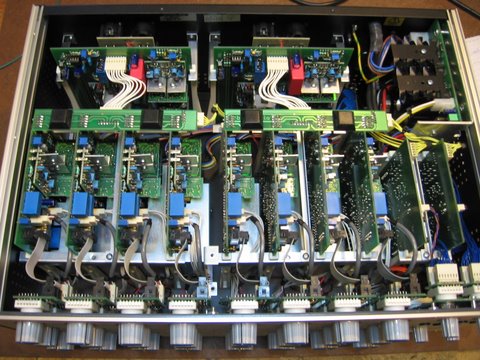Three months later from one of the top mastering plants in the world. (shameless self promotion, but hey, this is not a commercial, I don't think I'm going to find customers here, this is merely to boost my underdeveloped ego and tell that the design actually has real world potential)
The message is unedited. Well, removed names though.
"Let me say first I think the eq is an incredible engineering achievement! It is stunningly clean for a tube/L/C design. In fact my impression is it's one of the cleanest sounding eq's I've ever heard regardless of type. I used it on 2 occasions and on 4 or 5 different projects. It has a very precise feel to it, physically and sonically. I am very accustomed to eq'ing in M/S so that is a nice option to have. I mainly compared it to a very modified Sontec 430B that is my main eq. This particular Sontec is very transparent. Sometimes I would eq with the Soma and go with that, sometimes I would dial in a very similar setting on the Sontec and compare with an instant A/B via insert switches on the mastering console. Sometimes I went with the Sontec, sometimes the Soma. Compared to the Sontec on program material with heavy drum transients, I felt like the Sontec let a very small amount of punch through. Not good or bad, just what I observed and I mean a VERY small amount of transient difference. This was also coupled with the Soma having a very slightly rounder, fatter low end. Once again I'm talking miniscule difference, but audible. The high frequencies were similar with the Soma being possibly a tiny bit smoother. I think the quality to the highs are one of the eq's strong points. The mids seemed sonically similar, with the Soma having maybe a little more precise feel to it. That is, I could hear small changes in frequency choices and bandwidth a little better than the Sontec. Sometimes the mids on the Sontec felt a little 'larger' in a hard to describe way.
To some people, the Soma will be too clean sounding, to others the lack of any major coloration will be welcomed. I congratulate you on your acheivement!"
Perhaps there is a little irony in the fact that I'm using all kinds of components and techinques assosiated with (euphonic?) colorations and end up with nearly neutral gear. But that is very much what I tried to do.
Sorry for the "promo", but there is probably more to come on a bit more commercial scale, so you might excuse me.
-Jonte
(I switched to Soviet 6H30Pi tubes for the output stage (the first demo unit has C3g). Very nice tube indeed, highly recommended. With those oversized cathodes and a lot of gettering it will last for ages. I also combined shelf to Q rotary switch to improve ergonomics a bit)



